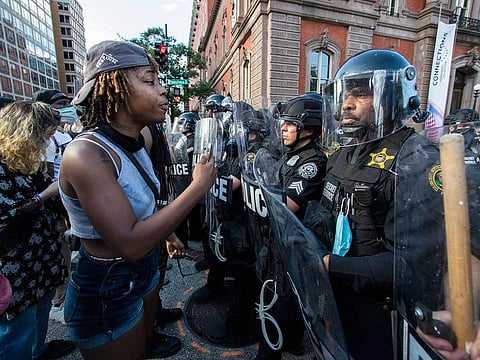Protests show US fell short of eliminating police racism
But calls for justice and end to police brutality doesn’t justify violence and looting

Thousands of people continued to protest across dozens of cities in the United States, with violent demonstrations stretching from coast to coast in a rare national show of rage against alleged racism and police brutality that saw buildings set on fire, businesses looted and an aggressive response from authorities.
The national protests came after the authorities announced on Friday that the white Minnesota officer who pinned George Floyd, a 46-year-old black man, to the ground had been arrested and charged with murder — a development that activists and Floyd’s family had called for but also said did not go far enough.
So far, several people have been killed in the protests and hundreds injured, including police officers and military personnel. President Donald Trump had made a series of statements in the past two days that did little to calm the Minnesota protesters. He alleged that the demonstrations are “professionally managed” and have nothing to do with justice. He called for a tougher response from local authorities including on the spot shooting of looters and rioters.
Trump, whose statement may have persuaded more people to join protests because of his seemingly unsympathetic remarks, could be partially right. Violent riots, looting and the destruction of public and commercial property certainly are not the right way to call for justice and an end to police brutality, especially at a time when cities in the US, like elsewhere in the world, struggle to overcome the economic impact of the coronavirus pandemic.
There have been some attempts in many US states since to clean up the security forces and end the racist practices. However, the Minnesota crime shows that there is still a long way to go.
Protests against police brutality and perceived racist practices by local law enforcement agencies, however, are not unusual in the US. Exactly 28 years ago, in May 1992, Los Angeles witnessed unprecedented six-day riots after a trial jury acquitted four police officers of using excessive force in the arrest and beating of a black man, Rodney King, which had been videotaped and widely viewed in TV broadcasts. Widespread looting, assault and arson resulted in the death of 63 people. More than 2,000 people were injured and more than 12,000 arrested.
There have been some attempts in many US states since to clean up the security forces and end the racist practices. However, the Minnesota crime shows that there is still a long way to go, especially with the rise of populist politics that have polarised societies worldwide.
With the intervention of the National Guard, and perhaps the army, the protests are likely to end soon. But such violent riots will recur unless the US took serious measures to eliminate racist tendencies in some of those who are in a position of authority.
Sign up for the Daily Briefing
Get the latest news and updates straight to your inbox







